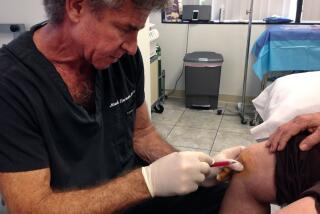U.S. to Name Facilities With Stem Cells for Study
- Share via
WASHINGTON — The National Institutes of Health plans to release today a widely anticipated list of companies and research laboratories that have colonies of human embryonic stem cells that President Bush said are eligible for research with federal funds.
The list, compiled by NIH officials during the last few weeks and kept secret since Bush’s announcement Aug. 9, includes some well-known research entities in the U.S. and abroad, and also some who are new to many in the field.
Together they have 64 self-renewing colonies, or lines, of stem cells available. They are at various stages of development and readiness for study, according to the NIH list.
Scientists familiar with the cell lines said some were well established and clearly bore all the molecular hallmarks of true embryonic stem cells, a kind of cell that can morph into virtually every kind of human tissue. Scientists hope to harness them to help patients in need of replacement tissues.
UC San Francisco was on the list, with two lines; San Diego-based CyThera Inc. was listed with nine lines.
Several of the research groups met with NIH officials last week to provide details about their cells and to discuss intellectual property concerns, which have complicated some groups’ willingness to share access to their cells. Others spoke last week with NIH officials by conference call.
Along with the names, NIH plans to release a few details about each group. After that, it might take time for more details to emerge, a source said, as each company decides how to deal with inquiries from scientists.
When Bush announced his decision in a nationally televised speech, he said he would permit federal money to be used for research on existing embryonic stem cells, which he put at 60 lines. The cell lines, taken from 5-day-old surplus embryos at fertility clinics, are believed to offer the hope of groundbreaking therapies for debilitating illnesses such as diabetes, spinal cord injuries, Parkinson’s disease and Alzheimer’s disease.
Until this month, scientific literature had identified no more than 20 cell lines. Even if 60 exist, medical researchers have raised concerns about the quality of the cell lines, who controls them and if proper donor consent has been obtained.






